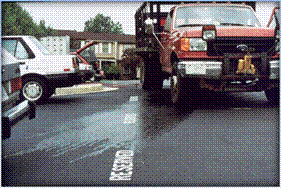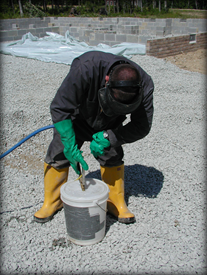Application Equipment Maintenance & Safety
Application Equipment Maintenance & Safety
Understanding proper equipment maintenance and safety is vital to preventing unwanted chemical spills, over-application or pesticide drift. Applicators need to take time to examine their equipment regularly for leaks, worn hoses and similar maintenance issues. They also need to exercise care when using the equipment since the equipment itself may pose dangers.
Protect Yourself
Whether working with or maintaining equipment used to apply pesticides, follow the same safety precautions as you would when mixing, loading or applying a pesticide. Remember that pesticide equipment is contaminated with pesticide residues and presents a risk to the user or mechanic, even when it is not being used to make an application. Be prepared for accidental exposure to substances which may be in hoses, drain lines or pumps.
- Consult the pesticide labels to determine what personal protective equipment (PPE) should be worn. When you are unsure of what pesticides are present, select PPE which provides the greatest protection. Anyone working on equipment should provide themselves with the same protection as the applicator or handler.
- Pesticides and Personal Protective Equipment: Selection Care and Use (Purdue Pesticide Programs)
- What you need to know about…Protecting Yourself When Using Pesticides: Why wear protective clothing (Penn State)
- Before working on application equipment, remove any remaining pesticide from the holding tank. Drain all pipes and hoses of sprayers into a suitable container for future use (do not use a food container). This will reduce the chance of pesticides leaking, spilling or splashing onto you while working on the equipment.
- Have an emergency eyewash kit nearby as well as decontamination supplies such as soap, a clean towel, a clean change of clothes and an adequate supply of clean water which can be used for washing.
- Train other family members or employees as well as yourself about emergency first aid for pesticide exposure and when to contact emergency responders if exposure occurs.
- Wash hands before eating, drinking, smoking, touching eyes or using the toilet.
- Don’t spread pesticides. Remove pesticide-contaminated clothes right away. Wash them separately from other clothing.
- Laundering Pesticide Contaminated Clothing (University of Missouri Extension)
- Laundering Pesticide-Contaminated Work Clothes (North Dakota State University Extension Service)
General Equipment Maintenance
When performing routine maintenance, cleaning or repairs, you should consult the equipment’s user manual (if provided) or contact the manufacturer or vendor for information specific to your equipment.
- Create a repair kit which contains basic tools necessary for small field repairs as well as replacement parts. These parts might include spare nozzles, pipe clamps, pressure gauges, anti-drip diaphragms, pump diaphragms and valves. For sprayers powered by small gas engines, keep spare pull string available. To determine which tools should be in the kit for routine repairs and maintenance, examine the sprayer and attachments. For small hand sprayers or backpack sprayers, an adjustable wrench (crescent), pliers, allen head wrench set, flat head screwdriver and Phillips head screwdriver may be sufficient. A multi-tool kit containing these tools may be the best option for keeping them together. If working away from your home, shop or farm, keep the kit with the equipment.
- Check nozzles for obstructions and remove any soil, dirt or debris. Use a soft-bristled brush when cleaning nozzles. Replace worn nozzles.
- Clean the sprayer regularly.
- Cleaning Your Sprayer (Cornell University)
- Maintenance, Cleaning and Storage of Ground Sprayers This publication from Montana State University discusses end-of-season maintenance, cleaning and storage practices for ground sprayers.
- Sprayer Clean-out Guidelines (University of Delaware Cooperative Extension)
- Cleaning Pesticide Application Equipment (University of Nebraska-Lincoln Extension)
- Decontaminating and Winterizing Airblast Sprayers (Cornell University)
- Calibrating Hand-Held and Backpack Sprayers for Applying Pesticides (Virginia Cooperative Extension)
- Compressed Air Sprayer Calibration (Pesticide Environmental Stewardship(PES))
- Hose-end Sprayer Calibration (PES)
- Siphoning Bucket Sprayer Calibration (PES)
- Trombone Bucket Sprayer Calibration (PES)
- Calibrating Your Lawn Spreader (Virginia Cooperative Extension)
- Lawn Care Pesticide Application Equipment: A Guide to Selection and Calibration of Granular Spreaders (Purdue Pesticide Programs)
- Drop Spreader Calibration (PES)
- Rotary Spreader Calibration (PES)
- Calibrating Spray Gun Applications to Turf (University of Illinois Extension)
- Calibrating the Hose Reel Lawn Care Sprayer (Purdue Pesticide Programs)
- Fine-Tuning a Sprayer with “Ounce” Calibration Method (Virginia Cooperative Extension)
- Fundamentals of Sprayer Calibration (VT Pesticide Programs)
- Calibration of Air-Blast Sprayers (University of Kentucky, Cooperative Extension)
- Check cut-off valves if present on spray rigs to make sure they function.
- If equipment has PTO connectors, pump shafts, motors or other moving parts, make sure shields are kept in place to prevent entanglement of clothing or hoses.
- Lubricate lid seals and rubber vent seals with silicone grease or petroleum jelly to prevent hardening.
- For equipment powered by small gas engines, change the oil and adjust.
- Examine filters and screens to make sure they’re intact and free of debris.
- Make sure pressure gauges are functional if present.
- Test backflow devices to make sure they are still effective.
- Backflow Prevention Guidelines for Filling and Rinsing Fertilizer or Pesticide Application Tanks (Minnesota Department of Agriculture)–The purpose of backflow preventers is to keep pesticides from being drawn into public waterlines or private water supplies when mixing pesticides. Some applicators have been in the practice of placing the water hose or pipe into the mixing tank when mixing pesticides. If there is a reduction or loss of water pressure, pesticides could be drawn into the pipes.


Hand-Held or Backpack Sprayers
Spreaders
Mounted, PTO-Driven Sprayers or Agricultural Sprayers
Stop Leaks Before They Occur
- DO NOT drag the spray gun.
- Examine and replace worn gaskets and seals.
- Replace hoses which are worn or have deep abrasions.
- Check connections to make sure pipes and hose clamps are tightened and there are no visible leaks.
- Store equipment in heated areas, or drain pipes and hoses prior to storage, to prevent expansion and cracking when temperatures go below freezing.
- Install cut-off valves between the mixing tank and the pump on spray rigs so the flow can be stopped if a break in the hose occurs.
- Keep hoses away from mufflers or exhaust pipes which can burn holes in them.
- Secure equipment when in storage or transport to minimize movement and impacts with other objects.
Personal Protective Equipment Cleaning and Maintenance
If available, consult the manufacturer’s use and care directions that accompany the personal protective equipment. The pesticide label may also provide some basic information related to clean-up after use.
Respirator Cleaning Procedures (OSHA) These are required procedures for occupational uses of respirators; however they are just as valid for homeowners who use respirators when applying pesticides.
Properly Cleaning and Storing Respirators (Ohio State University Extension)
Protect the Environment When Working on Equipment
- Refer to pesticide label precautions and instructions if available.
- Do not work on equipment in areas where spills or leaks could easily get into drains, ditches, gutters or bodies of water.
- Collect pesticides which may be in hoses or drains by using a bucket, plastic tub or similar container prior to starting work.
- Clean up any pesticide spills as soon as they occur. This would include leaks which occur inside the beds of trucks. Have a spill kit available which includes an absorbent material, such as kitty litter or dried gel, a flat shovel or dust pan, a bucket or similar container and a broom.
- Handling Spills (Pesticide Environmental Stewardship)
- How to Handle Chemical Spills (Penn State)
- Work over an impermeable surface where pesticide leaks can be contained and cleaned up. If a piece of equipment cannot be moved, a piece of heavy plastic can be placed under the equipment along with absorbent snakes to collect spills or leaks that may occur.
- Replace nozzles with ones that produce larger droplets. This will minimize the chances of drift since larger droplets are not carried as far by the wind.
- Control Your Drops – Includes information about droplet size along with video.
- Make sure edge guards are complete and functional on equipment used for applying granular formulations. Some newer spreaders have built-in edge guards which prevent granular formulations from being spread to either the right or the left of the spreader.
Related Resources:
Pesticides and Commercial Vehicle Maintenance This publication from Purdue Pesticide Programs briefly provides commercial applicators with information about vehicle safety and maintenance. Included with this is a Vehicle Maintenance Checklist that can be used for routine inspections of the vehicle.
Best Management Practices for Golf Course Maintenance Departments Although this publication was developed by the Florida Department of Environmental Protection, the principles and guidance contained in it can be valuable to golf course managers and others in Virginia.
Stormwater Management: Pesticide Use in the Lawn and Garden This publication produced by the University of Nebraska-Lincoln Extension discusses several topics and includes information about pesticide handling, spills, equipment maintenance and disposal.